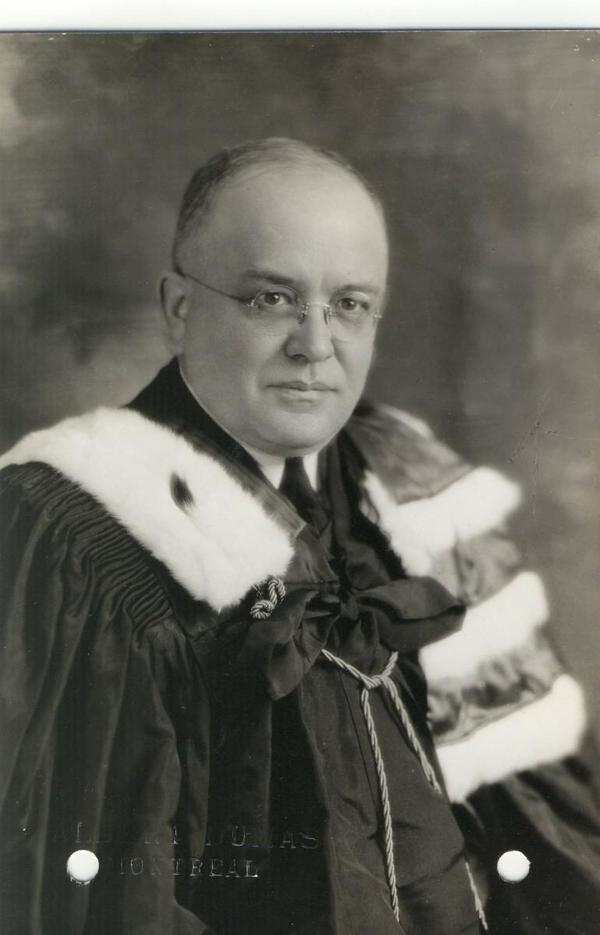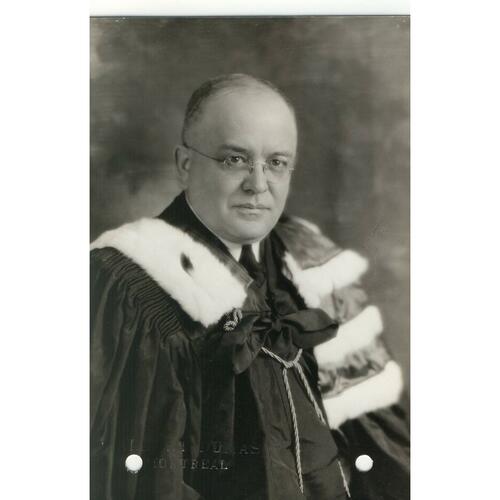
Source: Link
MAILHIOT, ADHÉMAR (baptized Joseph-Adhémar Mailhotte), civil engineer, professor, author, and school administrator; b. 11 March 1884 in Sainte-Julienne-de-Rawdon (Sainte-Julienne), Que., son of Félix Mailhotte (Mailhiotte), a farmer, and Carmela (Marie) Éthier; m. 14 Oct. 1914 Virginie Carey in Lacorne (Sainte-Sophie), Que., and they had six children; d. 21 April 1938 in Montreal.
Following his elementary schooling at the École Sainte-Brigide in Montreal, and classical studies at the Petit Séminaire de Montréal (1899–1905) and the Collège de L’Assomption (1905–6), Adhémar Mailhiot entered the École Polytechnique de Montréal in 1906. Four years later he graduated with honours in civil, chemical, and mining engineering. He was immediately hired as an assistant professor in the mining department of his alma mater; since the school had recently adopted a policy of offering its best graduates further training, he went to Paris to study mineralogy, geology, and petrography at the École Nationale Supérieure des Mines de Paris, the Sorbonne, and the Muséum National d’Histoire Naturelle. In 1912 he returned to Montreal to teach mineralogy and geology at the École Polytechnique. Two years later, when Émile Dulieux, professor and director of the provincial laboratory of mineral analysis, left to rejoin the French army, Mailhiot took over the course in mining and then, in 1918, assumed responsibility for the metallurgy class. He still cherished the hope of returning to Paris to complete his postgraduate education. His intention was to write a thesis there on the geological formations of the province of Quebec, but World War I made it impossible for him to leave the country. He succeeded Dulieux in the chair of geology at the École Polytechnique and at the provincial laboratory of mineral analysis in 1919. In 1920, as soon as the faculty of science was established at the Université de Montréal, he obtained a tenured position as professor of mineralogy and geology. In 1935 he was named head of the École Polytechnique, succeeding Augustin Frigon*, who became principal of the institution. That year the Université de Montréal granted him an honorary doctorate in applied science.
In addition to his career centred on the École Polytechnique, where he taught and which he ran, Mailhiot had a prominent role in developing the engineering profession among French Canadians. When he began his studies, positions in the industry were mainly held by anglophones who had graduated from the engineering faculties of McGill University in Montreal, the University of Toronto, or Queen’s College in Kingston, Ont. The position of French Canadian engineers was uncertain at the time in a community where the elite were defined as those who had attended the classical colleges and belonged to the liberal professions of law, notarial practice, or medicine. Both in Canada and elsewhere in the world, engineers adopted those professions as their models and provided themselves with tools to enhance their status and their role in society. Organized at first as the Association des Anciens Élèves de l’École Polytechnique de Montréal, French Canadian engineers took steps to secure the enactment of a statute governing the title of engineer and the practice of that profession (1918). Then, to ensure it was enforced, on 14 Feb. 1920 they formed the Corporation des Ingénieurs Professionnels de Québec. Mailhiot held the offices of secretary-treasurer (between 1916 and 1928), vice-president (1930), and then president (1931) of the Association des Anciens Élèves de l’École Polytechnique de Montréal, which he had also helped found. In addition, he was a member of the editorial committee and secretary of the association’s publication, the Revue trimestrielle canadienne. In these capacities, he worked hard to find employment for the graduates of the École Polytechnique. Thus, he was called upon to coordinate the forces trying to establish a strong identity among the members of this social group, whose importance went hand in hand with the economic and industrial development of the province of Quebec. Indeed, French Canadian engineers were then well represented in the field of education, and more and more of them held posts in public administration or served as consulting engineers in the private sector, thereby raising the visibility and prestige of the profession.
Training engineers and fostering development in this occupation were not Mailhiot’s only concerns. He acted as a consulting engineer and geologist for American and Canadian mining companies and as an expert in various lawsuits. He also did scientific work for the government and industry in the field of mining. After he was hired by the École Polytechnique, he went to the Gaspé in 1910 to conduct geological explorations for the Bureau of Mines of the Province of Quebec. In 1917 he prepared a report on the value of the zinc and lead deposits in this region, followed by a series of geological studies for different levels of government and private firms in the Eastern Townships, the Gaspé, and Abitibi. These explorations provided him with the material to write a number of geological reports, scientific pamphlets, and articles that appeared in the publications of the many technical societies to which he belonged. As the director of the provincial laboratory of mineral analysis, Mailhiot produced mineralogical estimates for prospectors at a critical point in the early stages of gold mining in the northwestern part of the province. At the same time he published guides intended for prospectors. His investigations, therefore, lay at the heart of entrepreneurial activity in a university setting, where, far from being confined to research and teaching, his work was contractual and practical. These pursuits should be seen as redefining the role of the university professor at a time when neither research nor the engineering profession nor the involvement of industry in the functioning of a university was highly valued.
The upsurge in mining activity had certainly contributed to these developments in Adhémar Mailhiot’s career. In the course of the 1930s, however, the provincial government realized the importance of this sector and decided to take over responsibility for its technical support rather than entrust it to the École Polytechnique. Hence, the mines branch set up a network of regional laboratories, which it centralized in a complex at Quebec City in 1937. As well, Onésime Gagnon*, the minister of mines in the government of Maurice Le Noblet Duplessis*, had plans to create a program of advanced studies in mining engineering. Two graduates of the École Polytechnique, Adrien Pouliot* and Mailhiot, and their respective institutions, the École Supérieure de Chimie at the Université Laval and the École Polytechnique de Montréal, vied acrimoniously for this project. In January 1938 the government decided to establish the mining school at the Université Laval. Mailhiot, who had been in frail health since being laid low by angina the previous year, died of a heart attack in his office at the École Polytechnique on 21 April.
Adhémar Mailhiot’s writings concern the engineering profession and teaching and research in mining geology. His articles appeared in Canadian Mining Instit. (it became the Canadian Instit. of Mining and Metallurgy in 1920), Trans. (Montreal), Rev. trimestrielle canadienne (Montréal), Canadian Mining Journal (Gardenvale, Que.) and Engineering Journal (Montreal). Of particular note are his “Geological reconnaissance in the Gaspe district,” which was published in Que., Dept. of Colonization, Mines and Fisheries, Mines branch, Report on mining operations in the province of Quebec during 1910 (1911), 86–94; “The new zinc and lead fields of Gaspé peninsula,” Canadian Mining Instit, Trans., 22 (1919): 368–77; and Descriptive report of the gold deposits of Lake Demontigny, Abitibi (Quebec City, 1922). Whether as a promoter of engineering education in general or of mining engineering at the École Polytechnique de Montréal, Mailhiot was an ardent supporter of his profession, as is shown by the following titles: Les succès des anciens de Polytechnique (Montréal, 1931); “Le génie civil” in Les carrières pour guider le choix des jeunes gens après leurs études classiques: III (Montréal, 1933), 9–16; and “La préparation de l’ingénieur des mines à l’École polytechnique,” L’Action universitaire (Montréal), 1 (1934–35), no.8: 6–7. Finally, his work on popularization for the general public or for interested prospectors merits particular attention: Dix conférences sur la formation des gisements minéraux (Montréal, 1935) and his translation of W. L. Goodwin’s A handbook of prospecting: prepared for the instruction and guidance of all prospectors, with special reference to the needs of those prospecting in Canada, published as Un manuel de prospection: préparé pour instruire et guider tous les prospecteurs, avec attention spéciale aux besoins de ceux qui font de la prospection au Canada (2nd ed., Gardenvale, 1932).
Arch. de l’École Polytechnique de Montréal, Dossier M. Dulieux, Émile; Dossier M. Mailhiot, Adhémar. BANQ-CAM, CE605-S29, 12 mars 1884. FD, Sainte-Sophie, comté de Terrebonne, Québec, 14 oct. 1914. Le Devoir, 22, 25 avril 1938. La Presse, 19 juill. 1919, 10 janv. 1920. J.‑F. Auger, “La recherche utilitaire dans les facultés de génie canadiennes: au service de l’industrie et du gouvernement, 1870–1950” (thèse de phd, univ. du Québec à Montréal, 2004). Robert Gagnon et A. J. Ross, Histoire de l’École polytechnique, 1873–1990: la montée des ingénieurs francophones (Montréal, 1991). Jean Hamelin, Histoire de l’université Laval: les péripéties d’une idée (Sainte-Foy [Québec], 1995). Ol[i]vier Maurault, “Nécrologie: Adhémar Mailhiot,” Rev. trimestrielle canadienne, 24 (1938): 113–15. Marc Vallières, Des mines et des hommes: histoire de l’industrie minérale québécoise, des origines au début des années 1980 (Québec, 1989).
Cite This Article
Stéphane Castonguay, “MAILHIOT, ADHÉMAR (baptized Joseph-Adhémar Mailhotte),” in Dictionary of Canadian Biography, vol. 16, University of Toronto/Université Laval, 2003–, accessed April 25, 2025, https://www.biographi.ca/en/bio/mailhiot_adhemar_16E.html.
The citation above shows the format for footnotes and endnotes according to the Chicago manual of style (16th edition). Information to be used in other citation formats:
| Permalink: | https://www.biographi.ca/en/bio/mailhiot_adhemar_16E.html |
| Author of Article: | Stéphane Castonguay |
| Title of Article: | MAILHIOT, ADHÉMAR (baptized Joseph-Adhémar Mailhotte) |
| Publication Name: | Dictionary of Canadian Biography, vol. 16 |
| Publisher: | University of Toronto/Université Laval |
| Year of revision: | 2019 |
| Access Date: | April 25, 2025 |



